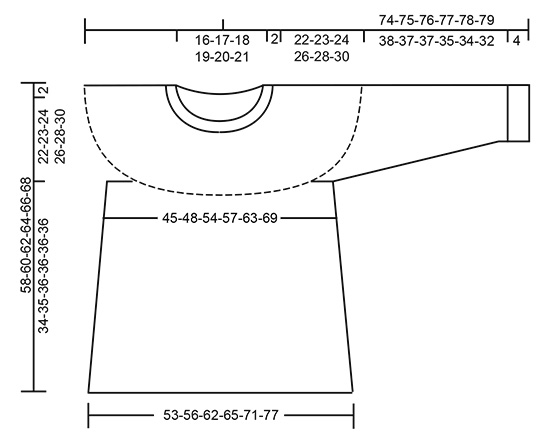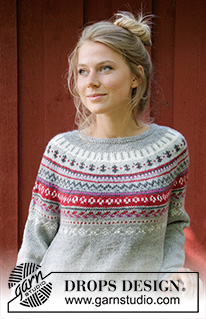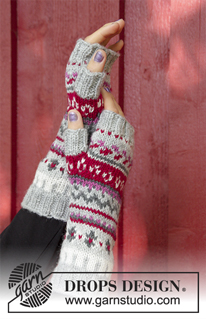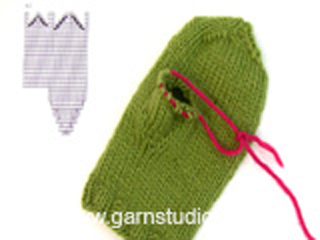Winter Berries |
|||||||||||||||||||||||||
 |
 |
||||||||||||||||||||||||
The set consists of: Knitted jumper with round yoke, multi-coloured Norwegian pattern and A-shape, worked top down. Sizes S - XXXL. Wrist warmers with multi-coloured Norwegian pattern. The set is worked in DROPS Karisma.
DROPS 181-16 |
|||||||||||||||||||||||||
|
INFORMATION FOR THE PATTERN: RIDGE/GARTER STITCH (worked in the round): 1 ridge = 2 rounds. Knit 1 round and purl 1 round. ELEVATION: Insert 1 marker at the beginning of the round = mid back. Start from the right side with light grey and knit until you have worked 11-12-13-14-15-16 stitches past the marker, turn, tighten the strand and purl 22-24-26-28-30-32 stitches. Turn, tighten the strand and knit 33-36-39-42-45-48 stitches, turn, tighten the strand and purl 44-48-52-56-60-64 stitches. Turn, tighten the strand and knit 55-60-65-70-75-80 stitches, turn, tighten the strand and purl 66-72-78-84-90-96 stitches. Turn, tighten the strand and knit to mid back. INCREASE/DECREASE TIP: To work out how to increase evenly, count the total number of stitches on the needle (e.g. 90 stitches) and divide by the number of increases/decreases to be made (e.g. 18) = 5. In this example, increase after every 5th stitch by making 1 yarn over, on the next round knit the yarn overs twisted to prevent holes. If you are decreasing, knit every 4th and 5th stitch together. KNITTING TIP-1 (for multi-coloured pattern): To prevent the knitting tension becoming tighter when working pattern, it is important that the strands do not tighten at the back of the piece. You can increase a needle size when working pattern if this is a problem. PATTERN: Jumper: See diagrams A.1 and A.2. Choose diagram for your size. Wrist warmers: See diagram A.3. The whole pattern is worked in stocking stitch. INCREASE TIP-1 (for the sides in the body): All increases are worked from the right side! Start 2 stitches before the marker thread, make 1 yarn over, knit 4 stitches (the marker thread sits in the middle of these 4 stitches), make 1 yarn over (= 2 stitches increased). On the next row (wrong side) purl the yarn overs twisted to prevent holes. DECREASE TIP (for mid under the sleeve): Start 3 stitches before the marker thread, knit 2 together, knit 2 (the marker thread sits in the middle of these 2 stitches), slip 1 stitch as if to knit, knit 1, pass the slipped stitch over the knitted stitch (= 2 stitches decreased). INCREASE TIP-2 (for the thumb gusset): Work as far as the stitch with the marker thread, make 1 yarn over, knit 1, make 1 yarn over (= 2 stitches increased). On the next round, knit the yarn overs twisted to prevent holes. The next time you increase, work as follows: Work until there are 2 stitches left before the stitch with the marker thread, make 1 yarn over, knit 3, make 1 yarn over (= 2 stitches increased). Continue the increases every 6th round, in this way, i.e. always increase on the outside of the increased stitches. ---------------------------------------------------------- JUMPER: The piece is worked in the round with circular needle, top down. The sleeves are worked in the round with short circular needle, top down, change to double pointed needles when necessary. NECKLINE: Cast on 90-94-98-102-106-110 stitches with circular needle size 3.5 mm and light grey. Work 3 RIDGES – see description above. Knit 1 round where you increase 18-20-22-30-32-34 stitches evenly on round – read INCREASE/DECREASE TIP = 108-114-120-132-138-144 stitches on needle. Continue by working yoke as described below. YOKE: Read KNITTING TIP-1! Change to circular needle size 4.5 mm and knit 1 round. For a better fit, you can now work an ELEVATION in the back of the neck – see description above. When the elevation has been completed, work A.1 in the round (= 36-38-40-44-46-48 repeats of 3 stitches). Continue the pattern in this way and, at the same time, increase on every round marked with an arrow in A.1 as described below – read INCREASE/DECREASE TIP and REMEMBER THE KNITTING TENSION! On the round with arrow-1 increase 30-30-36-42-42-42 stitches evenly on round = 138-144-156-174-180-186 stitches. On the round with arrow -2 increase 24-27-30-33-36-36 stitches evenly on round = 162-171-186-207-216-222 stitches. On the round with arrow -3 increase 24-27-30-33-36-36 stitches evenly on round = 186-198-216-240-252-258 stitches. On the round with arrow -4 increase 20-26-28-28-30-36 stitches evenly on round = 206-224-244-268-282-294 stitches. On the round with arrow -5 increase 18-24-28-28-30-34 stitches evenly on round = 224-248-272-296-312-328 stitches. On the round with arrow -6 increase 16-16-16-16-16-24 stitches evenly on round = 240-264-288-312-328-352 stitches. On the round with arrow -7 increase 8-12-12-12-16-16 stitches evenly on round = 248-276-300-324-344-368 stitches. On the round with arrow -8 increase 8-12-12-12-16-16 stitches evenly on round = 256-288-312-336-360-384 stitches. On the round with arrow -9 increase 12-16-20-20-20-16 stitches evenly on round = 268-304-332-356-380-400 stitches. After the last increase, the piece measures approx. 24-25-26-28-30-32 cm from the cast-on edge measured mid front. When A.1 has been worked 1 time vertically continue as follows with light grey: knit 41-44-49-52-58-62 stitches (= ½ back piece), place the next 52-64-68-74-74-76 stitches on a thread for sleeve, cast on 8-8-10-10-10-14 new stitches on the needle (= in the side under the sleeve), knit 82-88-98-104-116-124 stitches (= front piece), place the next 52-64-68-74-74-76 stitches on a thread for sleeve, cast on 8-8-10-10-10-14 new stitches on the needle (= in the side under the sleeve) and knit the remaining 41-44-49-52-58-62 stitches (= ½ back piece). Cut the strand. Body and sleeves are now finished separately. THE PIECE IS NOW MEASURED FROM HERE! BODY: = 180-192-216-228-252-276 stitches. Insert 1 marker thread in the middle of the 8-8-10-10-10-14 stitches which were cast on under the sleeve in each side. Start the round by one of the marker threads and work A.2 in the round (= 15-16-18-19-21-23 repeats of 12 stitches). When A.2 has been completed continue working in stocking stitch with light grey. When the piece measures 4 cm from the separation increase 2 stitches in each side – read INCREASE TIP-1 (= 4 stitches increased). Increase in this way every 4 cm a total of 8 times in each side = 212-224-248-260-284-308 stitches. Continue until the piece measures 32-33-34-34-34-34 cm from the separation. Change to circular needle size 4 mm and work 4 ridges. Cast off with knit, but to avoid the cast-off edge being tight, cast off with circular needle size 4.5 mm. The jumper measures approx. 58-60-62-64-66-68 cm from the shoulder down. SLEEVE: Place the 52-64-68-74-74-76 stitches from the thread on the one side of the piece on short circular needle size 4.5 mm and, in addition, knit up 1 stitch in each of the 8-8-10-10-10-14 stitches which were cast on under the sleeve, with light grey = 60-72-78-84-84-90 stitches on the needle. Insert 1 marker thread in the middle of the 8-8-10-10-10-14 stitches under the sleeve. Start the round here and knit 1 round. Then work A.2A in the round (= 5-6-6½-7-7-7½ repeats of 12 stitches). When A.2A has been completed, work stocking stitch with light grey. AT THE SAME TIME on the first round after A.2A decrease 2 stitches mid under the sleeve – read DECREASE TIP. Decrease in this way a total of 9-14-16-18-18-20 times; in S: Every 11th round, in M: Alternately every 6th and 7th round, in L: Alternately every 5th and 6th round, in XL and XXL: Alternately every 4th and 5th round and in XXXL: Alternately every 3rd and 4th round = 42-44-46-48-48-50 stitches. Continue working until the piece measures 38-37-37-35-34-32 cm from the separation. Change to double pointed needles size 3.5 mm and continue with GARTER STITCH in the round – see description above, for 4 cm. Cast off with knit, but to avoid the cast-off edge being tight, cast off with double pointed needles size 4.5 mm. The sleeve measures approx. 42-41-41-39-38-36 cm from the separation. Work the other sleeve in the same way. ---------------------------------------------------------- RIGHT WRIST WARMER: The piece is worked in the round with double pointed needles. Cast on 52-56 stitches with double pointed needles size 2.5 mm and light grey. Knit 1 round. Then work rib (= knit 2 /purl 2). When the rib measures 3 cm knit 1 round where you decrease 10-11 stitches evenly on round – read INCREASE/DECREASE TIP = 42-45 stitches. Change to double pointed needles size 3.5 mm and work A.3 in the round (= 14-15 repeats of 3 stitches). REMEMBER THE KNITTING TENSION! On the round marked with arrow-10 in the diagram, increase 0-3 stitches evenly on round = 42-48 stitches. Continue A.3. On the round marked with arrow-11 decrease 2-4 stitches evenly on round = 40-44 stitches. Continue A.3. AT THE SAME TIME when the piece measures 11-12 cm increase 1 stitch on each side of the first stitch on the round – read INCREASE TIP-2. Increase in this way every 6th round a total of 4 times (i.e. you always increase on the outside of the increased stitches so that you get a gusset for the thumb) = 48-52 stitches. After the last increase the piece measures approx. 18-19 cm. Continue the pattern. AT THE SAME TIME on the first round after the last increase, place the 9 thumb-gusset stitches on a thread, in addition cast on 3 new stitches on the needle over the stitches on the thread = 42-46 stitches. Complete A.3. Change to double pointed needles size 2.5 mm and knit 1 round where you increase 2 stitches evenly on round = 44-48 stitches. Work rib (= knit 2 / purl 2) for 3 cm. Cast off with knit over knit and purl over purl, but to avoid the cast-off edge being tight you can cast off with double pointed needles size 3.5 mm. The whole wrist warmer measures approx. 23 cm in both sizes. THUMB: Place the 9 stitches from the thread on double pointed needles size 3.5 mm and knit up 7 new stitches at the back of the thumb with light grey (i.e. knit up 1 stitch in each of the 3 stitches which were cast on + 2 stitches on each side of these 3 stitches) = 16 stitches. Work 2 rounds stocking stitch (make sure the thumb is not worked too tightly). Then work rib (= knit 2 /purl 2) for 3-3½ cm. Cast off with knit over knit and purl over purl. LEFT WRIST WARMER: Work as for right wrist warmer, but reversed, i.e. the increases for the thumb gusset are on each side of the last stitch on the round, instead of on each side of the first stitch on the round. |
|||||||||||||||||||||||||
Diagram explanations |
|||||||||||||||||||||||||
|
|||||||||||||||||||||||||

|
|||||||||||||||||||||||||

|
|||||||||||||||||||||||||

|
|||||||||||||||||||||||||
|
Have you made this or any other of our designs? Tag your pictures in social media with #dropsdesign so we can see them! Do you need help with this pattern?You'll find tutorial videos, a Comments/Questions area and more by visiting the pattern on garnstudio.com. © 1982-2024 DROPS Design A/S. We reserve all rights. This document, including all its sub-sections, has copyrights. Read more about what you can do with our patterns at the bottom of each pattern on our site. |
|||||||||||||||||||||||||

















































































Comments / Questions (21)
Na het breien van patroon A.2A in de mouw moet ik gaan minderen. Er staat minder 2 steken. Moet ik dan 2 steken samen breien if 2x2 steken? Alvast bedankt.
08.10.2023 - 12:03DROPS Design answered:
Dag M De Vries,
Je mindert verschillend aan elke kant van het midden, lees hiervoor 'TIP VOOR HET MINDEREN (voor midden onder de mouw)' bovenaan het patroon.
08.10.2023 - 16:57Is het de bedoeling dat het proeflapje op rondbreinaalden wordt gebreid? Of zijn gewone naalden ook goed? Alvast bedankt voor uw antwoord.
15.06.2023 - 21:23DROPS Design answered:
Dag Marion,
Je kunt het beste het proeflapje breien op de naalden waar je het uiteindelijke werkstuk ook mee gaat breien. Het kan namelijk zijn dat je losser of juist strakker breit op de rondbreinaalden.
18.06.2023 - 11:57Guten Tag Bei den Ärmeln habe ich 64 Maschen , muss ich dort 8 Maschen zusätzlich aufnehmen oder nur eine Masche. Herzlichen Dank
13.10.2022 - 08:23DROPS Design answered:
Liebe Gabi, in M sollen Sie 1 Masche in je die 8 Maschen unter die Ärmel auffassen - diese Lektion zeigt beim Bild 18a, wie das bearbeitet wird. Viel Spaß beim stricken!
13.10.2022 - 09:35Strikker pulsvarmerne - men kan ikke få mønster til at passe når jeg begynder at tage ud til tommelfingerkilen. Det synes jeg ikke der er taget højde for ?
19.12.2021 - 14:35DROPS Design answered:
Hei Tina. For å hjelpe deg best mulig er det fint for oss å vite hvilken str. strikker du, hvor i diagrammet er du når du gjøre første økning? Er det hver gang du gjør en økning at du mener det ikke passer? mvh DROPS Design
21.12.2021 - 11:34Winter berries u-823. Yoke: after the elevation,: work 1A after 1 row of grey. In the picture though the are several rows before A1? Or has she worn it backside front?? Just wandering how to do?
01.08.2021 - 09:17DROPS Design answered:
Dear Tuula, you should do the edge, and teh elevation befor the one knit row, and then start the pattern. Happy Stitching!
02.08.2021 - 01:08The part of the pattern for the sleeves refers to chart A2.A. Is this different to chart A2? I can’t seem to find it. Thank you
07.06.2021 - 21:17DROPS Design answered:
Dear Alison, A.2A refers to the cardigan version of this modell. Happy Knitting!
07.06.2021 - 23:37I’m struggling to understand how to read the diagram and would appreciate some help please! I’m knitting a Medium size so rows 1-3 knitted in light grey across the row (increasing on R3) then rows 4-12 do I knit 1 stitch in light grey then 2 sets in white and repeat across the row? Thank you
30.01.2021 - 14:56DROPS Design answered:
Hi Sue, It is correct: in size M: rounds 1-3 are in light grey (do not forget to increase evenly 30 sts in round 3); rounds 4-12 work 1 st in light grey and 2 sts in off white and repeat it across the round. Happy knitting!
30.01.2021 - 17:59What gauge is this pattern... needke sz and stitches
08.10.2020 - 18:56DROPS Design answered:
Dear Mrs Flitney, you will find the gauge and needle size as well as yarn required under the header, jumper and wrist warmers do not use both same needle size/tension. Happy knitting!
09.10.2020 - 07:32Hallo, wie stricke ich den Übergang an der hinteren Mitte, damit man den Wechsel von der einen zur anderen Farbe nicht so sieht? VG Manja
03.11.2019 - 17:22DROPS Design answered:
Liebe Manja, je nach den Reihen vom Muster können Sie diese Technick stricken. Viel Spaß beim stricken!
05.11.2019 - 07:51Hi im working on this sweather and im at the point where i need to cast on the 8 stitches under the sleeve, is there a video that shows this, Ive put the 64 stitches on the thread for the sleeve, but where do i take the 8 stiches from, this is a new technique for me, Thanks so much for your help
28.03.2019 - 03:28DROPS Design answered:
Hi Deb, You cast on the 8 stitches from the last stitch on the body (before the stitches you have put on a thread for the sleeve) and then continue working the stitches on the other side of the sleeve. I hope this helps and happy knitting!
28.03.2019 - 07:07